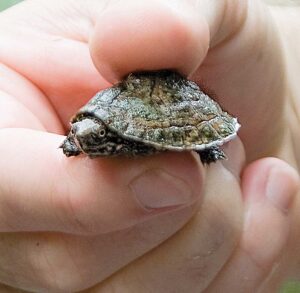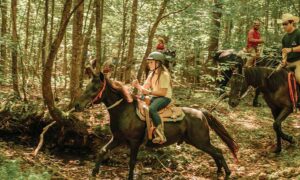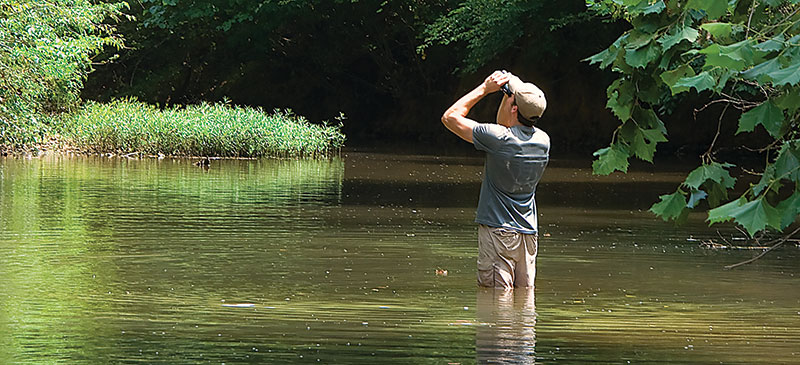
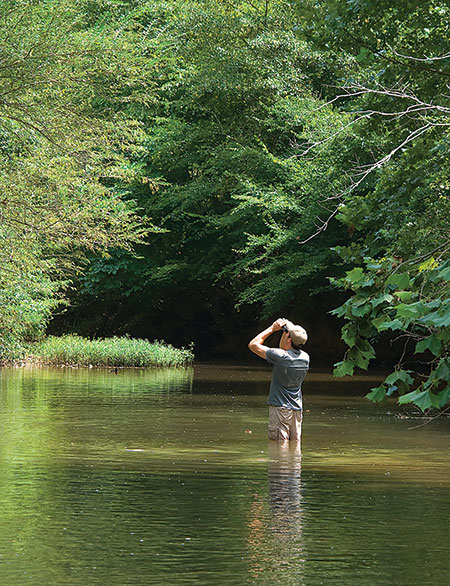 Big Canoe Creek Preserve
Big Canoe Creek Preserve
in Springville is now
a part of Forever Wild
Story by Carol Pappas
Photos by Susan Wall
and Emily Y. Horton
He was no doubt inspired by the groundwork they meticulously laid in making a compelling case for saving this property for the future, others entered the picture to eventually move this project over what had been an elusive finish line.
Prominent Springville businessman Dean Goforth, helped them navigate the political process. So did Candice Hill and Don Smith of the St. Clair Economic Development Council. Vickey Wheeler, a local artist and head of Nature Planning for Friends was among those helping push it to fruition.
Wendy Jackson, former executive director of Alabama Freshwater Land Trust and now executive VP of the Land Trust Alliance in Washington, D.C., was instrumental as was Barnett Lawley, former commissioner of the Alabama Department of Conservation and Natural Resources and now a board member of the St. Clair EDC.
“The Big Canoe Creek Preserve is perseverance at its finest,” Jackson said. “So many people committed to making the preserve a reality and never quit. Doug Morrison and all of the Friends of Big Canoe Creek, the City of Springville, St. Clair County Commission and Freshwater Land Trust were early champions and stayed the course, even when success seemed far from certain.
“Kudos to their forward thinking and leadership that created a remarkable legacy for my beloved home county. I grew up playing in Canoe Creek and look forward to visiting this new beautiful, preserve that brought so many people together. For me, it will always stand as a symbol to great character of the people in St. Clair County and why, no matter where my travels take me, I am so proud to call it home!”It is easy to use words like perseverance when describing the project’s history. At one point in the process, “They were at a place where they felt like it was dead,” said Goforth. “It wasn’t going anywhere.” He worked with State Rep. Jim Hill and State Sen. Jim McClendon as well as State Lands Manager Doug Deaton of ADCNR.
Referring to Morrison and the Friends of Big Canoe Creek, Goforth said they had done “an awesome job of nominating the property and helping people understand its importance.” Because of the relationships he and others had, they were able to combine forces and work together to take the effort to a whole new level.
“It was a team effort,” Morrison said. The city of Springville, St. Clair County Commission and various state officials and agencies invested all the support that was needed, and the preserve became official. “It will benefit people from now on,” Goforth added.
They predicted it will become one of the premier destinations in the state. It’s centrally located. It’s easy to access. And it has it has a number of diverse development possibilities over time, including horseback riding, canoeing, kayaking, bird watching, hiking, walking trails and possibly, mountain bike trails.
Look in any direction, and you cannot help but see an outdoor classroom surrounding you. The education component is limitless. Goforth called it a “huge opportunity from an education standpoint” with schools and colleges as natural partners along with other organizations who will use it as a teaching and research tool.
“The impact of this project will be felt across St. Clair County, both from a tourism perspective and a preservation presence,” said Retail Development Specialist Candice Hill of St. Clair EDC.
“Because Springville is already set up to receive tourism dollars in its retail districts, they will feel the spinoff immediately. The participation of both St. Clair County and the City of Springville in this projects says to all of us that they care about the quality of life and the preservation of green space, and we look forward to the future of this preserve,” she said. “Over 100,000 people visited the Forever Wild prerserve at Turkey Creek last year, and if we see similar results, this could really help local businesses.”
Preparing for the future
On an August morning of overcast skies, dozens of volunteers, environmentalists and conservationists combed the tracts of land that run along Big Canoe Creek looking for even more reasons – species – this watershed should be preserved.
 Two graduate students from the University of Alabama, Frank Gigliotti and Thomas Franzem showed up for the Bio-Blitz “just for fun. They were there looking for species of birds and insects. They are working with the State now for a return visit for a more thorough exploration.
Two graduate students from the University of Alabama, Frank Gigliotti and Thomas Franzem showed up for the Bio-Blitz “just for fun. They were there looking for species of birds and insects. They are working with the State now for a return visit for a more thorough exploration.
Kim Waites of Wild South, a leader in public lands protection in the Southeast, volunteered to map the distance of the entire border of the property and look for places to develop trails.
Henry Hughes, retired director of Education at Botanical Gardens, a forester by trade, was looking forward to his first Bio-Blitz as well. His task would be identifying the trees found on the expansive parcel.
Educator Lacy Kamber talked of the programs Turkey Creek, where she works, has put in place. Named a Forever Wild property in 2008, its 466-acre park in Pinson is a growing attraction. It has six miles of hiking and biking trails and a creek that is “incredibly clean” with a waterfall that visitors can tube down, a natural waterslide. With more protected species than any other preserve, Turkey Creek has earned a reputation for its richness in education, recreation and environmental resources.
It is known for three species of darters, one of which – vermillion – is on the critically endangered species list. It only exists in 10 square miles of Turkey Creek.
About Big Canoe Creek
Big Canoe Creek has plenty of its own precious resources. The main part of the creek is more than 50 miles long with four tributaries flowing into it – Gulf Creek, Muckleroy Creek and two “Little Canoe” creeks.
Along its shores, the preserve is home to a mix of oak-hickory and oak-pine forests. Thickets of mountain laurel and native azaleas populate its slopes.
Bordering the creek are Beech, Red and Sugar Maples, Hornbeams, Catalpa, Butternut and Big Leaf Magnolia trees. In limited supply, but nevertheless dwelling n the land, are fire suppressed stands of river cane.
The creek itself is home more than 50 species of fish, including a rarity, the Trispot Darter, discovered in 2008 in Little Canoe Creek – a species that used to occur in Alabama but had not been observed in nearly 50 years. It is a species of conservation concern in Alabama, Tennessee and Georgia and is under review by the US Fish and Wildlife Service for listing under the Endangered Species Act.
Because it had not been collected in Alabama since the mid-20th Century, it was considered locally extirpated. With the discovery of the Trispot Darter, it is now designated, “Highest Conservation Concern” by the Alabama Department of Conservation and Natural Resources.
Mussels – nature’s water filter – are in great supply in Big Canoe Creek, illustrating and ensuring the creek as an ecological treasure. The creek has retained a majority of its mussel species. They are the most endangered because of their dependency on exceptionally high water quality.
Big Canoe Creek watershed has eight federally listed freshwater mussel species associated with it. And an 18-mile stretch of its main stem was designated in 2004 as a “critical habitat” under the Endangered Species Act. A distinct new species, The Canoe Creek Clubshell, only found in Big Canoe Creek, has been discovered in one of its tributaries.
Conservation status is designated for 10 species of mussels in Big Canoe Creek. Two species have state conservation status while eight have designations under the Endangered Species Act. Three of the eight are known from historic records only. Of the remaining five extant species, three are listed as endangered, one as threatened, and another is proposed for listing.
Dr. Wayne Barger of Alabama Department of Conservation, State Lands Division, talked of the importance of adding to the collections and identifying the species, like those found in the Bio-Blitz. “We are still working to get all the data identified. It was a good day. It adds to our knowledge as we move forward.” Regarding its potential, Barger added, “It scored well as a nature preserve. This will protect its diversity” and allow people to observe nature, bird watch and hike – “enjoy nature as it should be.”
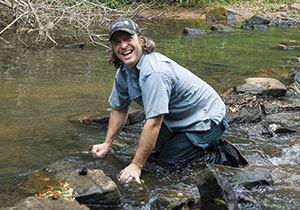 “For The Friends of Big Canoe Creek it has always been about protecting and educating ourselves and our community about Big Canoe Creek,” said Vickey Wheeler.
“For The Friends of Big Canoe Creek it has always been about protecting and educating ourselves and our community about Big Canoe Creek,” said Vickey Wheeler.
“The Big Canoe Creek Nature Preserve is our ‘living museum.’ We are planning ways everyone of all ages and abilities will have the opportunity to observe and learn about the natural world. A system of educational, gentle walking trails in combination with more strenuous hiking trails is what we are looking at first for public use. Whichever direction our community chooses to support, we must put the health and protection of the creek at the forefront of all decisions we make in planning Big Canoe Creek Nature Preserve.
Healthy creeks equal healthy communities.”
Future plans will include ways to connect with the city and bring support to local businesses. “We are continuing our talks with the city and county to bring more conservation areas into Alabama,” she said.
Evan Lawrence, a biologist in State Land Recreational Management, said his group is working closely with Springville to guide the process. “Plans call for a hiking trail system through there, mountain biking trails and possibly horseback trails.”
As the preserve nears opening in about six months, boundaries are being marked, a gate will be installed at the entrance to the property, the road is being improved and a kiosk in the parking area will be set up to offer information about the property.
Development of it will come in phases en route to a preserve destined to become a destination point, supporters say.
Success at last
Why so much preliminary work? Alabama’s biodiversity ranks Number 1 in so many categories, first in the U.S. in freshwater fishes, freshwater snails, freshwater mussels, crayfish and turtles. It is important to document the flora and fauna on this tract of land and the creatures in the creek. It gives historical data about the existing ecosystem and helps us better understand this Nature balance. Are there existing conditions affecting the plants or wildlife? Invasive species are everywhere, how bad is it here? Where exactly are they on the property? Are there any rare species found? Where can new trails go that won’t affect any special plants found?
Nine years is a long time for a quest, but Morrison said all the work and the angst were worth it in the end. But he is quick to point out that it really isn’t the end, it’s a new beginning.
“At one time, there was talk of a development on this property, and we were concerned about the effects this would have on the creek as this property borders the creek. As we were looking for ways to preserve this property, Vickey Wheeler and I had a meeting with two members of Springville’s Planning and Zoning group, Stephen Graham and David Jones. Mr. Jones, now on the City Council, pointed out the Forever Wild program to us. We took the idea and ran with it.
“Alex Varner, now with The Nature Conservancy, a good friend and fellow Friends member, went with me to meet one of the landowners on the property and pitch the idea to him, to let The Friends of Big Canoe Creek nominate this property to Forever Wild. I’ll never forget the landowner asking how long it would take. I said then, “I have no idea, but what do you have to lose?” Who knew it would take nine years? One of our board members, Sean Andrews, was very beneficial in drawing up the necessary documents, maps, etc. for the nomination package and the journey began.”
Help along the way
“We met Wendy Jackson with the Freshwater Land Trust, and she was very instrumental from the beginning. She helped pitch the idea of a different type of economy with green space to the City of Springville and St. Clair County. We met with the Springville City Council and the St. Clair County Commission, and they jumped on board and assisted financially to make this happen,” Morrison said. “This would not have happened, period, without their backing.
“Libba Vaughn carried the torch after Wendy left FWLT and attended the Forever Wild Board meetings with us. There were many roadblocks along the way, a lot of heartaches, headaches and frustrations, but we never lost hope.”
Morrison expressed gratitude to Friends members and board members, Mayor Isley for seeing the possibilities and believing in the project, the St. Clair Commission chairmen, Stan Batemon, originally, then Paul Manning, the Springville City Council, the St. Clair County Commission, Candice Hill, Don Smith and Dean Goforth for “helping get us to the goal line. Myself, I had many sleepless nights in those nine years – too many to count. The bottom line is, we got it going, the community paid attention, and the resources needed joined forces to make the Big Canoe Creek Nature Preserve a reality.”
“I believe that part of the the impact of the Forever Wild nature park in Springville will be to provide an untouched, natural and beautiful portion of God’s creation – Earth – made available to our citizens, neighbors, families and friends,” said Springville Mayor William “Butch” Isley. “The users of this beautiful sanctuary full of wildlife, fish and foliage will be able to spend time there in wonder and bewilderment at the beauty of this preserved area.”
In addition, he said, “The city of Springville – its citizens, businesses, churches and community residents will be benefitted in many ways by hosting guests and visitors from all parts of St. Clair and surrounding counties as everyone hears about this beautiful nature park.”
A bright future
“I see the Forever Wild program as a unique way to preserve property in the State of Alabama, for the good of the State and its people. We hope this Big Canoe Creek Nature Preserve will benefit folks in our communities, benefit our educational institutions for research, outdoor classrooms, etc., and help maintain a natural balance for generations to come,” he said.
With an unmistakable passion, he added, “Big Canoe Creek is a special tributary. I know this Preserve just adds a small bit of protection from over development along the creek, but perhaps it can serve as food for thought. It will be wonderful to see folks getting outdoors and just enjoying nature for what it is. Take a clean breath and enjoy a little bit of tranquility while observing nature. I think folks will come, especially when the weather is cool, to enjoy a hike, get some exercise and just unwind. It may be like Field of Dreams, in reverse. If you don’t build it, they will come.”













